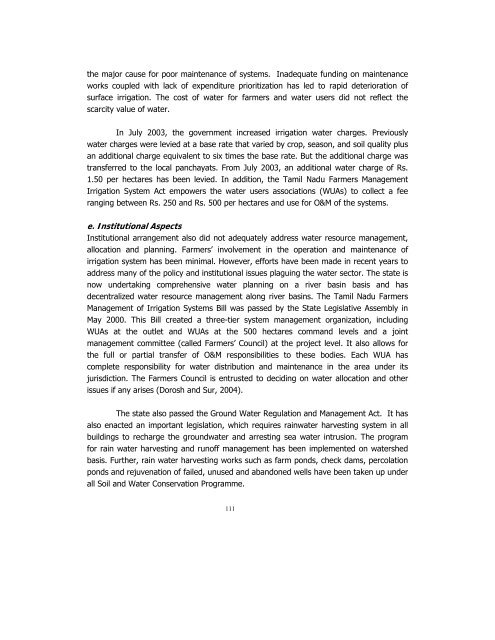POVERTY REDUCTION STRATEGY TN
Create successful ePaper yourself
Turn your PDF publications into a flip-book with our unique Google optimized e-Paper software.
the major cause for poor maintenance of systems. Inadequate funding on maintenance<br />
works coupled with lack of expenditure prioritization has led to rapid deterioration of<br />
surface irrigation. The cost of water for farmers and water users did not reflect the<br />
scarcity value of water.<br />
In July 2003, the government increased irrigation water charges. Previously<br />
water charges were levied at a base rate that varied by crop, season, and soil quality plus<br />
an additional charge equivalent to six times the base rate. But the additional charge was<br />
transferred to the local panchayats. From July 2003, an additional water charge of Rs.<br />
1.50 per hectares has been levied. In addition, the Tamil Nadu Farmers Management<br />
Irrigation System Act empowers the water users associations (WUAs) to collect a fee<br />
ranging between Rs. 250 and Rs. 500 per hectares and use for O&M of the systems.<br />
e. Institutional Aspects<br />
Institutional arrangement also did not adequately address water resource management,<br />
allocation and planning. Farmers’ involvement in the operation and maintenance of<br />
irrigation system has been minimal. However, efforts have been made in recent years to<br />
address many of the policy and institutional issues plaguing the water sector. The state is<br />
now undertaking comprehensive water planning on a river basin basis and has<br />
decentralized water resource management along river basins. The Tamil Nadu Farmers<br />
Management of Irrigation Systems Bill was passed by the State Legislative Assembly in<br />
May 2000. This Bill created a three-tier system management organization, including<br />
WUAs at the outlet and WUAs at the 500 hectares command levels and a joint<br />
management committee (called Farmers’ Council) at the project level. It also allows for<br />
the full or partial transfer of O&M responsibilities to these bodies. Each WUA has<br />
complete responsibility for water distribution and maintenance in the area under its<br />
jurisdiction. The Farmers Council is entrusted to deciding on water allocation and other<br />
issues if any arises (Dorosh and Sur, 2004).<br />
The state also passed the Ground Water Regulation and Management Act. It has<br />
also enacted an important legislation, which requires rainwater harvesting system in all<br />
buildings to recharge the groundwater and arresting sea water intrusion. The program<br />
for rain water harvesting and runoff management has been implemented on watershed<br />
basis. Further, rain water harvesting works such as farm ponds, check dams, percolation<br />
ponds and rejuvenation of failed, unused and abandoned wells have been taken up under<br />
all Soil and Water Conservation Programme.<br />
111

















